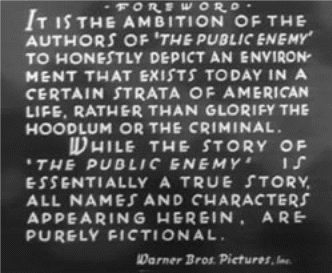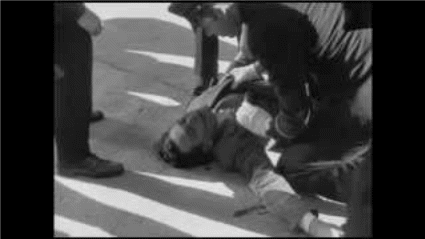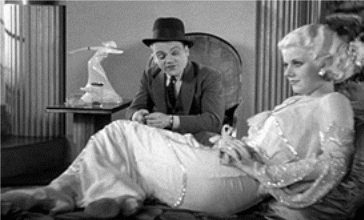Introduction
The Public Enemy, directed by William Wellman and aired in 1931, is considered one greatest gangster film of all time. While it was popular both in America and abroad, it is much more important to the history of cinema for its uneasy relationship with the Hays Code, introduced in 1930 as an attempt by the MPPDA to invoke self-censorship. While the foreword at the beginning of the film claimed that the sole purpose of it was to “honestly depict an environment that exists today in strata of certain American life, rather than glorify hoodlum or the criminal” (The Public Enemy), the effect of the film was the exact opposite.
It made the audience sympathize with the gangsters rather than hate them. The film was also famous for scandalous scenes of sex and seduction, production and distribution of illegal alcohol, and depiction and glorification of the gangster lifestyle, which contradicted greatly to the Hays Code. The main characters of the film were Tom Powers and his sidekick Matt, who lived lavish and extravagant lives. Many Americans during the time of the Great Depression were struggling and desired wealth, power, alcohol, and beautiful women.
This made the gangsters very relatable to the audience. Although some attempts to adhere to the Hays Code are visible, the film deterred from the code’s tenets more than it obeyed them by glorifying the gangster lifestyle, primarily because most of America during the 1930s could identify with struggles of a typical American gangster.
Analysis
The 1930s were the times of the Great Depression in the USA. The word “depression” was used to describe not only the economic crisis but also the attitude of the people. Moviegoers were seeking to escape reality and forget about their problems for at least a few hours. Money and work were scarce, so people did what they could to keep their spirits high. Many Americans were immigrants that wanted to fit in and make a life for themselves. To the public, criminals and gangsters were akin to celebrities – they had everything.
Money, women, cars, nice and expensive cars – you name it, they had it. They even had the fame they did not deserve. The people identified with the criminals because they had the same drives and desires. The images of luxury and extravagance were teasing to the hungry and depraved audience. The movie highlighted the modern notion that crime was “cool.” This trend, visible in other movies that predated The Public Enemy, was the reason for the appearance of the Hays Code.
The Motion Picture Production Code, also known as the Hays Code, was a set of moral standards and guidelines that were meant to prevent the filmmakers from glorifying criminals and other anti-social elements. It was named after Will H. Hays, who was the president of the MPPDA from 1922 to 1945. During his time in power, the code was very strictly enforced. Although he possessed much power on his own, the man also had powerful allies in the Catholic Church, which helped him project control over the motion picture industry.
The Catholic “Legion of Decency” had a lot of say in the country – after supporting the ban on alcohol production, they extended their reach towards the cinema. Hays collaboration and religious support promoted further censorship of gangster films. The code possessed a rigid set of “do’s” and “don’ts,” and the entire genre of gangster films fell directly into the “don’t” category. Sympathy for criminals, firearms, negative depictions of the law enforcement, seduction and sex scenes, use of alcohol, and general violence were either prohibited or managed very carefully.
In order to get his film through, William Wellman was forced to adhere to the Code to some marginal degree. The foreword at the beginning of the film stated that the creators of the film did not have the intention of glorifying criminals or promoting violence; they only wanted to depict their lives in a realistic manner. This statement was important, if true. No motion picture that had violence in it was allowed on the screen without it.

To adhere to the Code, most death scenes in the movie were off-screened. It was done with the purpose of not showing the actual moment of death but letting the audience know that the character indeed died. The scene where Tom and Matt murder their childhood acquaintance, named “Putty Nose,” illustrates it perfectly. The criminals enter Putty Nose’s parlor and threaten his life, to the point of forcing him to beg for it. He tries to make them recall the good times they had together and even decides to play the piano for the criminals. While he is singing, the camera pans to Tom, who pulls a gun out of his pocket, letting the audience know something that Putty does not.
Then, the camera moves to Matt, in an over-the-shoulder shot. We hear gunfire and the clamorous sound of piano keys as Putty collapses over them. Although we were not shown the body during this scene, we could tell that Putty Nose was killed (The Public Enemy).
However, compliance ends here. One of the film’s central motives is violence. Many characters are murdered throughout the entire story, including both the main characters. Although their deaths are not explicitly shown, the implications are often bitter and gruesome. This is illustrated best with the scene of Matt’s death. His death is largely shown through the crosshairs of the gun. The guns are in the foreground as they are hovering above the window seal. They are the focus of the camera, and Tom’s escape following Matt’s death is considered largely irrelevant, taking only a little bit of screen in the corner.

The camera then switches to Matt’s distorted figure on the ground, as pedestrians and shooters alike are rushing to him (The Public Enemy). The scene itself is brutal and demonstrates the significance of violence and murder in the film.
Women and scenes of seduction are amply present in The Public Enemy. While nothing explicit is shown, in accordance with the Code, the setup of the mise-en-scene involves women in seductive poses and wearing pajamas, who find themselves in the company of men. This heavily implies they have been sleeping together. Tom and Matt break the Hays Code in many ways, as they are depicted picking girls off from the streets and in restaurants, which was strictly forbidden by the moral rules of cinema. Showing infidelity, relationships outside the wedlock, flirting and seduction were frowned upon. The film hardly makes any effort to hide it.

The Public Enemy portrays criminals and their actions through a lens of rogue charm and glamor. In contrast, the efforts of law enforcers that try to stop them are viewed in an unfavorable light. This is best demonstrated during the robbery scene when Larry dies. The audience knows that Larry is innocent, unlike the two gangsters, and sympathizes with him. Yet, he is gunned down by the police officers that arrive at the scene of the crime and open fire without trying to figure out who is who.
This entrenches the audience against the police, despite the fact they are technically the “good guys” who arrived to stop an armed robbery. Larry’s death is off-screened, like all others, showing only his body distorted after being hit. The camera focuses on his hand limply holding the small gun. Thus, the police are portrayed as the antagonists, not heroes (The Public Enemy).
Conclusion
The reasons why William Wellman’s The Public Enemy earned its popularity because it gave the people what they wanted to see – images of a better life, illusions of grandeur, and characters that, while villainous, are likable and relatable to the audience. The moviegoers grew tired of the same generic heroes that the Hays Code seemed to propagate and enforce in every instance, often making them root for the villain. Making the main characters, villains eliminated the boring generic hero out of the equation.
Although The Public Enemy makes a formal attempt to fit the Hays Code with the clever use of film shots to deliver the message while avoiding explicit scenes of death, it disregards the Code on most occasions. The film contradicts its foreword in almost every way. It glorifies gangsters and criminals because the kind of lives they lived was desirable for many hard-working Americans of that time.
Work Cited
The Public Enemy. Directed by William Wellman, Warner Bros, 1931.